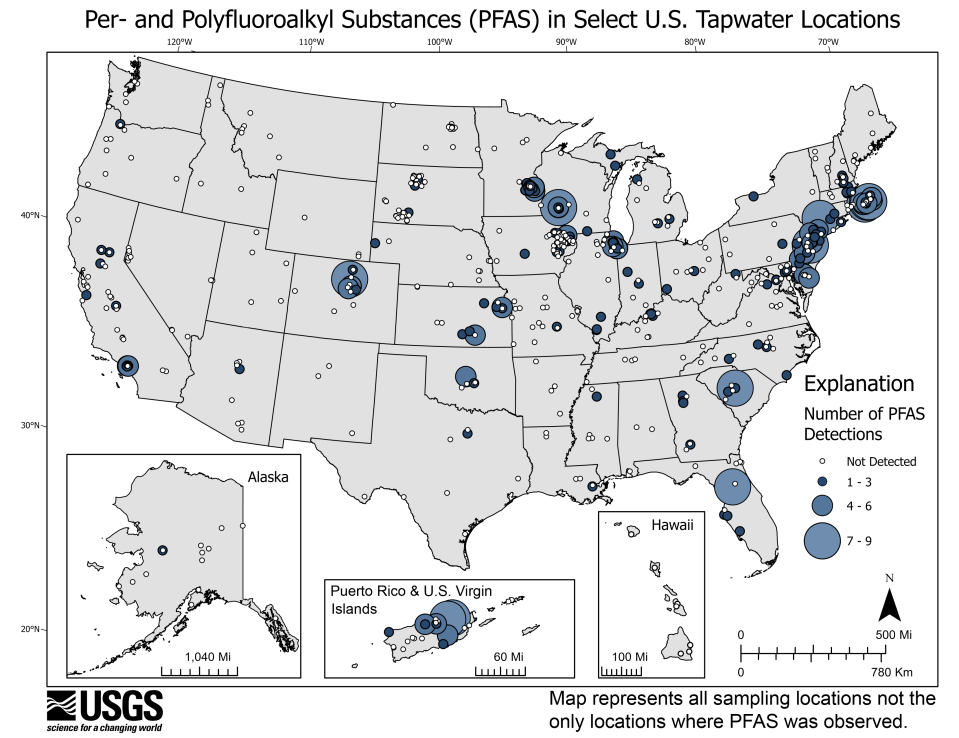Study suggests 'forever chemicals' could be in 45% of American homes, a figure that tracks Wisconsin findings
MADISON – Nearly half of U.S. households could have some sort of "forever chemical" contaminants in their tap water, according to a new study from the United States Geological Survey that closely tracks the findings of a Journal Sentinel investigation in Wisconsin.
The study estimated that 45% of tap water in the country contains one or more PFAS.
Last summer, the Journal Sentinel collected and analyzed tap water from 40 Wisconsin communities. About 40% of the samples had detectable levels of at least one type of PFAS, with 30% of the samples above the very low health action limits recommended by the Environmental Protection Agency last year.
For the USGS survey, 716 tap water samples were collected and analyzed from across the United States, representing areas with high, medium and low-level impacts from humans, according to the study. The low category included protected lands, the medium category included residential and rural areas with no known PFAS sources, and the high category included urban areas and locations with reported PFAS sources such as industry or waste sites.

For the most part, PFAS were detected in urban areas and potential PFAS sources. Scientists estimate that the probability of PFAS not being found in tap water is about 75% in rural areas and around 25% in urban areas.
In Wisconsin, the USGS survey tested eight sites — three private wells and five public drinking water systems. All of them had detections of PFOA or PFOS above the federal recommendations of 4 parts per trillion, but below the state's regulation of 70 parts per trillion.
The survey didn't list locations where the samples were collected, because they came from individual households, but the data still helps to give an idea of how widespread the issue could be, said Kelly Smalling, a USGS research hydrogeologist and one of the authors of the study.
It also provides more insight into the impact on private wells, Smalling said, which hasn't been looked at as much as public water systems. Concentrations and the compounds found in private wells were similar to what was found in systems, she said.
"In areas where maybe we don't have information on private wells, people could actually look to their public supplies and see what the PFAS risk of exposure in public supply is to kind of get a better understanding of what may be going on in their private well," she said. "It's definitely not going to be a one-to-one relationship, but I think it starts to give private-well users a little more information than they had a couple of weeks ago."
PFAS, or per- and polyfluoroalkyl substances, are a family of man-made chemicals used for their water- and stain-resistant qualities in products like clothing and carpet, nonstick cookware, packaging and firefighting foam. The family includes 5,000 compounds, which are persistent, remaining both in the environment and human body over time.
More: Residents urge lawmakers to give DNR more authority to address 'forever chemicals'
The chemicals have been linked to types of kidney and testicular cancers, lower birth weights, harm to immune and reproductive systems, altered hormone regulation and altered thyroid hormones. The chemicals enter the human body largely through drinking water.
PFAS have been found across the state in communities like La Crosse, Marinette, Peshtigo, Milwaukee, Madison, Rib Mountain, the Town of Stella, Rhinelander and Eau Claire.
As the number of contaminations grew across the state, regulators worked to create regulations, which went into effect last year, setting the 70 parts per trillion standard for drinking water. The federal government's regulation of 4 parts per trillion will likely go through months, if not years, of evaluation before it's enacted into any type of law.
The state doesn't have regulations for groundwater, but the Department of Natural Resources this year began the three-year rulemaking process to establish those. In Wisconsin, about 1 million households rely on private wells, or about 30% of the state's population.
In the meantime, the small dataset from the USGS could help regulators make more informed decisions at the state and local level.
Steve Elmore, the drinking water and groundwater program director for the Wisconsin Department of Natural Resources, said that having data like this is only going to help form better regulations to protect people.
"Having more information about the distribution of PFAS in drinking water across Wisconsin and the nation, whether from a public water system or a private well, is critical for developing sound policy for protecting all Wisconsinites from PFAS exposure," he said. "Without understanding where water is PFAS-impacted, we cannot take steps to efficiently address its contamination."
And while regulations are still being worked on, those worried about their tap water could use this data to make informed decisions about treatment options, or use it to encourage their local public health agency to do a round of PFAS testing.
"It's a personal issue, and if folks are really worried about the quality of their drinking water, they can use this information," Smalling said. "And they can evaluate their own personal risk."
Laura Schulte can be reached at leschulte@jrn.com and on Twitter at @SchulteLaura.
THANK YOU: Subscribers' support makes this work possible. Help us share the knowledge by buying a gift subscription.
DOWNLOAD THE APP: Get the latest news, sports and more
This article originally appeared on Milwaukee Journal Sentinel: PFAS could be in 45% of US tap water, study suggests

